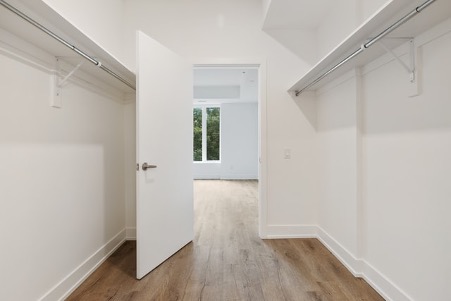A walk-in closet might look like it contains a surplus of space, but if it is not organized properly, it will become a free-for-all of clothes, shoes, accessories and knickknacks that have assumed a life of their own – the sort of cluttered chaos that ultimately defeats the purpose of having such a large space with the potential to make life easier.
Stacy Scuderi blogs about organization, style, and design and below she explains how exactly to approach a chaotic closet and turn it into an asset for your home.
1. Empty the Space First, then Choose the Right Storage Strategy
Stacy Scuderi explains that before you begin to build your new closet, its best to empty out the whole space and taking a critical look inside to decide on what to use.
For example, hangers are often handier to maximize capacity, rather than bins and drawers. We mention some ways to optimize drawer space below but utilize as much hanger space as possible. Built in wall storage units could also be handy.
2. Eliminate the “Dead” Spots
Closets have hard to reach corners that go unused more often than not, according to Stacy Scuderi. Utilize accessories such as a hydraulic pull out clothes rod, which will keep clothes out of the way when you don’t need them but can be pulled out when you do.
Another such device would be a corner carousel, which can be used to hang clothes all around the central pole, with a swivel function that allows for easy reach towards specific items of clothing.
Finally, use hangers and hooks wherever there is a stretch of wall that normally stays unused. This creates less clutter than a bulky drawer or bin down at ground level but also allows you to use the height and also have clothes hanging at eye level.
3. Utilize the Full Height of the Closet
The topmost areas of the closet, close to the ceiling, are often unused. Install high shelves with bookends to compartmentalize the area. Stock items that you may not use for a while – e.g. seasonal clothing or clothes for special occasions – up top. Invest in a step ladder to be able to reach up high.
Stacy Scuderi says ultimately, having some non-regularly used items out of the way will create more space and less clutter below. You could even consider putting out-of-season clothes in plastic wraps and store them under your bed to save space.
4. Organize Clothes for Easy Access
Color coding shirts or dresses is a good start. A great next step would be to get casual wear, formal wear and occasional wear clothing in their own area and color coded. The most frequently worn clothes should be placed in one spot. This makes organizing and access easy.
Another great idea might be to put hooks on empty wall space. Now, consider choosing your outfit for the next day ahead of time and hang them on a hook close to the door. That way, your day gets off to a fast start.
5. Considering Shoes, Ties, Socks and Belts
Shoes are essential, of course, but they often cause the most clutter says Stacy Scuderi. Figure out the most optimal arrangement for better organization and convenience. For example, get a wall with shoe racks installed. They will stay out of the way, but you can pick out what you need quickly.
For ties, socks, belts etc. consider utilizing built-in drawer inserts, aka cellarets. Keep the items folded and confined within the compartments.
6. Use Accessories to Create Space and Take Care of Your Clothes
Little things can make a big difference. For example, you could use shoe boxes to create compartments inside your drawer space. That way, you can keep items in their specific areas – less mess and easier to find.
Similarly, you can use ice cube trays for your jewelry. What about using cut out segments of pool noodles as inserts for your shoes? That way, they do not lose their shapes.
7. Take Stock, and Purge!
Stacy Scuderi says that besides the organizational tips above, you have to help yourself by taking stock of things that are languishing in various corners of your closet. Find items that you have not touched for months, sometimes years.
You can initially move them down to the basement or up to the attic. If you then find six months, or a year, has passed and you have not needed to bring anything back, consider donating that box to Goodwill or the Salvation Army. No need to have the clutter in your closet or even your house.
The Last Word
You can hire professional designers to help create an ultra-modern, spacious closet. But the tips provided by Stacy Scuderi above may be far easier, and cheaper, to implement. Give them a shot first.









